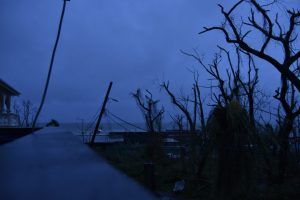Tom Winterbottom in Public Books:
 It has been a year since Hurricane Maria devastated Puerto Rico, leaving a trail of destruction: ruined infrastructure, destroyed homes, and thousands of fatalities. Since that particular hurricane has largely faded from the news, the slow rebuild continues and defining questions loom over the process: Who is Puerto Rico for? Outside investors and tourists or Puerto Ricans? After a collective trauma like Hurricane Maria, who has the right to decide for Puerto Rico? The fight for its future is underway.
It has been a year since Hurricane Maria devastated Puerto Rico, leaving a trail of destruction: ruined infrastructure, destroyed homes, and thousands of fatalities. Since that particular hurricane has largely faded from the news, the slow rebuild continues and defining questions loom over the process: Who is Puerto Rico for? Outside investors and tourists or Puerto Ricans? After a collective trauma like Hurricane Maria, who has the right to decide for Puerto Rico? The fight for its future is underway.
This fight began immediately after the hurricane. Electricity, hospitals, water, roads, and more: all would require rebuilding, a process that could take two paths. Given the desperation and distraction brought about by the disaster, the federal government, corporations, and investors sensed an opportunity: Puerto Rican society was at its most vulnerable, making it the perfect time to snap up bargains, privatize industry, and remake the island. A small elite of non-islanders, who own and control infrastructure and resources, would benefit from the profit-driven privatization and monetization of the island, which has been touted as the libertarian enclave of cryptowealth, a tax haven for certain private interests.
The other possibility, as the activist Naomi Klein writes in her new book, The Battle for Paradise: Puerto Rico Takes on the Disaster Capitalists (2018), is to look for positive, real change in the island’s future after decades of oppression.
More here.
